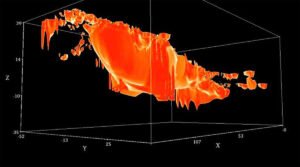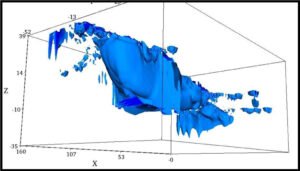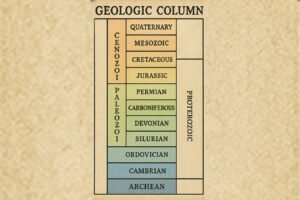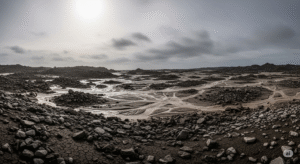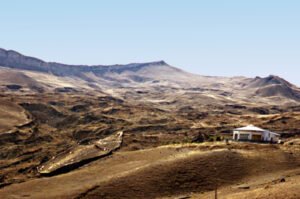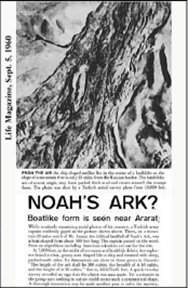Treachery & Radar
September 1985- Radar MUST be Done
Ron knew that radar scans were the next thing that had to be done. But he would never have the money to even rent it and a radar operator and bring them to Turkey. So he prayed about it and then went to talk to a Tennessee businessman, Mr. Ellsworth McKee, owner of Little Debbie Cakes, who was known to assist financially in projects he felt were worthy.
The radar system would be capable of sending frequency signals down into the ground that would encounter an object or obstruction. The shape of the object would return to the unit where it would be recorded. It is far more complicated than that but it is solid science.
A Provision for Radar
After Ron explained about the radar and the real need for it, Mr. McKee agreed to purchase a system which he would own but which he said he would allow Ron to use. He placed the order and even had it shipped to Ron's home in Madison, Tennessee.
Ron immediately took it to the Customs office at the airport and completed the required forms which he tucked into the radar case. It was too late to use it that year but Ron wanted to be ready to go as soon as possible. He wrote his name on the card that came with it and placed it in the glassine window of the large, gray case which held the cables and one of the antennas. He was ready! Then, the owner's office contacted Ron and said they wanted to use it on one of their building projects, so Ron drove it down to their offices in Collegedale, Tennessee, near Chattanooga.
Same Day- A Book Contract with Rene Noorbergen of the 1960 Expedition
Another exciting prospect arose the very day Ron met with Mr. McKee. Somehow, Rene Noorbergen found out Ron was coming to Collegedale and he called Ron. Rene asked him to stop by his house because he wanted to discuss something with him. So after Ron met with Mr. McKee, he drove over to Rene's house which was also in Collegedale.
Ron had invited Rene to Nuweiba, Egypt in 1978 because when they met and talked about the 1960 expedition to the boat-shaped object, Ron had discussed his research about the Red Sea crossing site with him. Rene would later write positively about Ron's research in that area in another of his books, so Ron considered him a friend.
Ron Confided in the Wrong Person
He kept in touch with Rene as his research into the Red Sea crossing site and Mount Sinai in Saudi Arabia continued. In fact, in 1983 when Ron was planning on sneaking into Saudi after years of being refused a visa, Rene was one of only two people that Ron confided in about his plan. The Saudi authorities had been the ones to tell Ron it was Rene who had reported him as being a spy for Israel. Since Ron never planned on his sons coming with him, Rene didn't know that fact ahead of time and I'd like to think he wouldn't have reported Ron as a spy if he had known.
Ron had never told him that he had been told by the authorities that Rene had been the one who called the Saudi Arabian Embassy back in 1984 and told them that Ron was an Israeli spy which resulted in their imprisonment for 75 days in Saudi and 3 days in Jordan. So he was cautious with Rene but remained cordial.
When Ron arrived, Rene explained that he wanted to write an update to his book, "The Ark File" with all of Ron's research included in it. "The Ark File" was the book Ron had read which told about the 1960 expedition.
Ron knew he was an excellent writer and Ron's theory was to get him involved in the work and make him an ally. So he was very happy to sign a contract with him.
You can read this contract below:
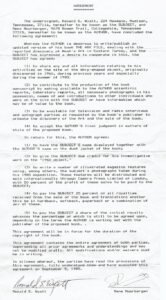 Contract between Ron Wyatt and Rene Noorbergen.(© Mary Nell Lee)
Contract between Ron Wyatt and Rene Noorbergen.(© Mary Nell Lee)
Ron wasn’t very savvy when it came to contracts and while this one sent up a few red flags, he didn’t have any idea what Mr. Noorbergen really had in mind. But he soon would.
The contract signed, Mr. Noorbergen was ready to go to Turkey since he hadn’t been to the boat-shaped object since the 1960 expedition and hadn’t seen it since the earthquake which caused the earth to fall from around its sides. He also wanted to see the drogue stones and other objects Ron had found in Arzap and photograph everything for the new book. Excited by the prospects of such progress, Ron agreed to return in October with him. This would give him an opportunity to meet with Turkish officials about obtaining the radar permits and Mr. Noorbergen could take photographs for the book.
October 1985- To Turkey with Rene Noorbergen
Ron arrived in Turkey on October 23, 1985 and met up with Mr. Noorbergen in Ankara. Orhan Baser joined them as liaison and translator. Several days later, arriving in Dogubeyazit in the afternoon, they went out to the village of Arzap since it was closer to the hotel than the boat-shaped site and they had a limited amount of time before nightfall. This, Ron believed, would make the best use of the limited time they had.
The First Red Flag
Ron planned to show Mr. Noorbergen the objects and artifacts in and around Arzap, but when they arrived Ron was bothered by the very large, professional-looking video camera that Mr. Noorbergen had with him which Ron hadn’t seen until that time. Ron became suspicious since Mr. Noorbergen was supposed to be there to get photographs for the book– not video.
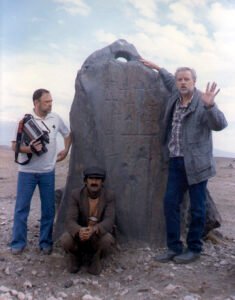
When Mr. Noorbergen continued to take video, Ron asked him why he wasn’t taking photographs. A spirited disagreement followed and Ron and Mr. Baser quickly decided it was time to leave the village. They knew they should not allow the villagers to see them arguing. The area was still not safe and Ron still believed some of his attackers from 1977 were from the village and were still living there.
The Second Red Flag
In the taxi, there was now silence between the men. When the taxi pulled up in front of the hotel, Ron and Mr. Baser went to their rooms but Mr. Noorbergen failed to follow. After a while Ron went downstairs to the restaurant. As he entered the lobby, he heard Mr. Noorbergen’s voice and froze, listening while he stood out of his sight. Mr. Noorbergen was on the telephone in the lobby, talking to someone about a deal with the BBC to do a documentary on the ark.
Thus ended the relationship between the two men. Ron knew Mr. Noorbergen had a right to make a documentary on anything he wished but he wasn’t going to do it with Ron’s research. Ron walked on into the restaurant and had supper. The next morning, he got up early and went to the site with only his taxi driver accompanying him. The ribbons from the metal detector survey of just two months earlier were still there.
Meetings in Ankara Before Leaving
After leaving Dogubeyazit, Ron met with officials in Ankara about the permits for the radar. He didn’t want to go to all the trouble of bringing Mr. McKee’s radar to Turkey only to be denied permission to use it. He was assured by the Turks that he would be allowed to use the radar because it was nondestructive. He only needed to apply for the permits well enough in advance for them to be processed properly.
He was warned that a potential problem could be getting the radar system through customs and then getting it back out of the country safely if all paperwork with customs was not done properly. G.S.S.I. had taken care of that with their equipment and had no problems so he was not overly concerned about it.
Ron had no idea when Mr. Noorbergen left Turkey but he now knew he could not work with him. He viewed this as a real loss because of Mr. Noorbergen’s talent as a writer.
The Radar Arrives at Ron's Home
After his return from Turkey, the radar from G.S.S.I. arrived at Ron’s home. Included with the system was training for an operator at their facility in Hudson, New Hampshire. Ron wanted to go for the training later, nearer the time he would perform the scans which he planned to do in June of the next year.
As soon as it arrived, Ron took the radar system to the Nashville Airport Custom’s office to discuss with them how to properly do the paperwork to ensure no problems. He filled out a Certificate of Registration for Personal Effects Taken Abroad, signed it and had it signed by the Custom’s official. He then placed a copy in each of the cases which held the equipment.
Back at home, he wrote his name and address on the provided card and reinserted it in the glassine window of the main radar case and put stickers with his name and address on the other two cases. He then took the equipment down to Mr. McKee’s office when they called him and asked him to bring it as they wanted to use it for something.
Arranging to do Radar Scans
Ron called Mr. Fasold and told him the good news, that they would have the use of a radar system. It wasn’t the SIR-8 that Mr. Fenner had brought back in August, but the SIR-3 was certainly capable and should get the job done. The men agreed to return to Turkey in June of 1986 to perform the radar scans.
A Catastrophic Turn of Events
All appeared to be going well until a little over a month later when the letter from Mr. McKee arrived. Dated December 18, 1985, it began with Mr. McKee’s complaint that the radar cost about $5,000 more than Ron had originally told him he thought it would be. But it was the final paragraph that dealt the death blow:
"I keep hearing different things and people I know have also heard additional things that you are supposed to have said. Some feel that you are really an independent and are not working with any recognized archaeology group. Because of this, along with the equipment costing so much more than I originally planned on spending, I believe you need to find someone else to buy the expensive equipment for you. I cannot be at liberty to send this equipment to Turkey to chance on ruining it or losing it...."
It was signed, “Sincerely, Ellsworth McKee.” Ron was devastated. He had no idea what had caused such a change of heart in the few weeks since he’d taken the radar down to Mr. McKee.
Winter turned to spring and, unwilling to give up, Ron returned to Turkey in May to again talk to the Turks in person about the possibility of doing some limited excavation. He had become quite friendly with some of the officials and he felt he had nothing to lose except the airfare.
Why Ron was Denied the Use of the Radar by Mr. McKee
Ron later learned why his change of heart. Back in August, 1985 during the time "20/20" was there, the Turkish newspapers were full of "ark stories." One paper, which is exactly like our "rag mags" here, printed a totally fictitious story about a feud between Col. Jim Irwin and Ron. Jim was sort of a hero in Turkey and was always in the news whenever he was there, and this made Ron a target for any kind of story that would attract readers.
Since Ron headed the team which believed the ark was not on Mt. Ararat, he was chosen as the antagonist. On the front page were photos of Ron and Jim, with captions that each said pretty terrible things about the other, in Turkish, of course.
Rene took this opportunity to double cross Ron. He gave a copy of the newspaper to Mr. Mckee and even provided a translation, convincing him that Ron was not to be trusted and was up to no good.
Praying about Doing Radar Scans
This was a tremendous blow to Ron but he was getting used to it by now. It was as if there was an unseen struggle going on constantly. Sometimes Ron's side seemed to gain the victory and sometimes the dark side gained a few points. Just as he always did, Ron kept praying for answers. After praying about it for a while, he was impressed with "Yes, you will get to do the radar scans."
He was so convinced that he returned to Ankara on May 6, 1986 and again applied for permits. If he didn't get to do the scan, at least he'd have the permit. He had become quite friendly with some of the officials and he felt he had nothing to lose except the airfare.
Stranger than Fiction- Two Chance Encounters in the Amsterdam Airport
On his way to Ankara in May of 1986, during a layover in Amsterdam while awaiting his flight to Turkey, he went to the food area to get a quick bite to eat. There, for a very brief moment, his eyes made contact with someone very familiar. Suddenly, the man darted around the corner but not before Ron recognized Rene Noorbergen. Ron grabbed a quick bite and headed back in the direction of his gate. He knew Rene traveled extensively in his work and thought nothing of it other than that it was a coincidence.
Then, as he returned down the long hallway back to the gate area, he saw another familiar face. Dave Fasold was walking in the opposite direction, back towards the food area. This was another coincidence within less than fifteen minutes. Each, I’m sure, wondered what the other was doing or where they were going, but according to Ron, neither asked. They exchanged brief greetings but their conversation quickly ended with both men expressing urgency to get to their respective gates and that they would talk later. Ron figured something was brewing but had no idea what it could be.
Something was up, but What?
Ron proceeded to Ankara and met with officials. Permission to do any type of excavation was again denied. He learned from one official that Mr. Fasold had just met with them a few days earlier and made applications for permits but nothing had been set. That explained seeing Dave in the airport. But not Rene.
Ron left Turkey just three days later, wondering what was going on. He had come too far and worked far too long on this to give up. But something was going on with Mr. Fasold and Mr. Noorbergen, he was quite sure.
Call to Dave Fasold to Go Do Radar Scans
Back at home, Ron called Mr. Fasold in early June and asked him if he still wanted to go to Turkey as they had originally planned. Dave had received training on the radar and Ron couldn't do it without him. But he didn’t mention the fact that he wouldn’t have Mr. McKee’s radar. Without questioning Ron as to details, Mr. Fasold’s answer was affirmative providing Ron could pick up the tab. Ron agreed.
What was Ron thinking, paying to take Dave over when he didn't even have the radar? When I questioned Ron about this, he only said he had prayed about it and knew he was supposed to go.
You Can't Make This Story Up- It's Too Bizarre!
The two arrived in Turkey on June 21, 1986 and proceeded to the Kent Hotel in Ankara where Ron always stayed. For the first time in Ron’s experience, the hotel was full. Mr. Fasold didn’t hesitate a moment before recommending another hotel– the Dedeman Hotel. They soon found themselves checking in.
While each was settling down in their respective rooms, Ron heard a knock on his door and answered it, expecting to see Mr. Fasold. Instead, it was one of the men from the hotel’s reception. In broken English he tried to explain something to Ron about their having some luggage with his name on it. But Ron knew his luggage was all accounted for in his room and he was puzzled.
The man beckoned him to follow. He proceeded downstairs with Ron following and unlocked a door which held a number of suitcases and odd boxes. As his eyes surveyed the room, Ron saw the transit case with the radar unit and the large padded case with the antenna and cables! The cases still had his name and address on them that he had put there when the equipment first arrived at his home.
When he recovered from his initial shock, Ron asked the man to have someone bring the equipment to his room. His mind a blur, he called home to get Mr. McKee’s telephone number and proceeded to call him at home that night, which was early Sunday morning in the U.S. Ron explained to Mr. McKee exactly what had happened and that the radar had apparently been abandoned in the hotel by someone. Mr. McKee was shocked but offered no other information.
Ron asked him if he wanted him to bring the equipment home with him when he returned. Mr. McKee, startled at the least, responded, “Yes.” His heart pounding, Ron then asked the most important question: since he was in Turkey and the radar was in Turkey, he asked for permission to take it to the site and do a scan before he brought it home. To his excited relief, Mr. McKee again said, “Yes.”
Rush to Dogubeyazit to do Radar Scans
With permission to use the radar, Ron and Mr. Fasold headed to Dogubeyazit. The area was still unstable and without any soldiers accompanying them, Ron was nervous. Again, he was very aware that the equipment could be confiscated once they were in Dogubeyazit.
His plan was to do a quick scan and if the results were what they expected, they would then call Dr. Shea and Dr. Baumgardner to come over and be present for a complete series of scans which they had agreed to do. At that time, he would request military accompaniment at the site.
But he didn’t want to do anything that might jeopardize their getting the first scans so he decided they should slip in unannounced, do the scans and then get out. It was taking a chance but he believed it was the way to handle it.
After landing in Erzurum, they enlisted taxi driver, Dilaver Avci, to take them on the long drive to Dogubeyazit. Early the next morning, they took the radar to the site.
Brief Explanation About the Sub-Surface Interface Radar
With great anticipation at what they might or might not see, the men took the radar to the site. Mr. Fasold, as mentioned, had received training on the use of the system at Geophysical Survey Systems and he set right to work, unpacking the system and attaching the 12 volt car battery and cables.
The Geophysical Survey System, Inc. SIR 3 consisted of the model PR-8300 profiling recorder and the model 3102 transducer which had nylon skids on the bottom surface which allowed it to be pulled easily and smoothly along the ground. It also had a tow handle with a marker switch which allowed the person pulling the transducer to press a button and place event markers on the printout at survey markers.
Since the transmitter/receiver (transducer) would be pulled manually, a constant rate of travel was not possible. This meant the printout would not reflect a completely constant picture of what was being scanned. If the operator walked at a faster rate at one point, ten feet of horizontal travel distance might be reflected on the scan printout at a length of one inch while at another point where he walked a little slower, ten feet of data might be recorded as more than an inch. The video tape would help pinpoint the locations.
Another method to note reference points was also employed. Dave set up green stakes as references at the locations of 15 metal readings obtained from east to west across the boat shaped object. On one scan, as the transducer was pulled alongside the path of these stakes, the operator would press a button as each stake was passed which would place an ‘event marker’ on the scan printout to note the location. Thus the internal readings could be compared with the metal lines they had obtained with the metal detectors.
Drum Roll- the Scans Begin!
The machine whirring, they began the scans. In order to document the procedure properly, Dave operated the scanner’s profiling recorder and made notations as to location on the scan printout. Dilaver Avci pulled the transducer as instructed by Dave while Ron videotaped and photographed the procedure.
Before their eyes, the printout revealed a pattern of reflections that seemed to match the iron lines they had detected with the metal detectors. With little time to complete this initial group of scans, they recorded a total of 10 passes, including the first test pass.
Ron believed that within the site would be found the remains of structures– walls, joists, and floors that had once been wood but were now turned to stone by a mineral replacement process. Whether any of the wood remained or not really didn’t matter. The radar would detect the difference in density between the soil and the structure members if any were present.
The initial passes definitely showed something beneath the surface that was in a transverse pattern that was consistent as each scan was performed.
Video: The very first radar scan:
Dr. Bill Shea and Dr. Baumgardner to Come to Turkey
After the successful passes, Ron, Dilaver and Dave returned to the hotel in Dogubeyazit. Ron called Dr. Shea and Dr. Baumgardner with the news and arrangements were made for them to come over for more in-depth scans.
Ron then went to Ankara to get the permits which could take several days. June turned into July when Dr. Baumgardner’s group arrived. This included his wife and financier Tom Anderson with a film crew. They also brought a hot-air balloon which they planned to use to film the site from the air. It appeared that this was the much anticipated moment.
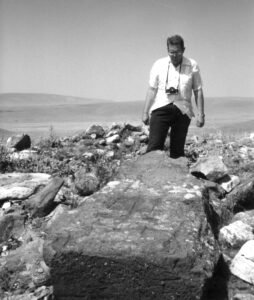
Disaster Strikes
But things did not work out the way everyone intended. Ron had left Ankara and was on his way back from Agri when disaster struck. While Dr. Baumgardner’s group was erecting the hot air balloon in the hotel parking lot, it caught on fire. The ensuing blaze caused such a commotion that they were effectively shut down.
Ron arrived back in Dogubeyazit to find this situation. When Dr. Shea later arrived, the site was closed and he never got to see the object of his many years of study and efforts.
How the Radar Came to Be in Ankara
Rene Noorbergen had convinced Mr. McKee to let HIM bring the radar to Turkey to do the scans. After discrediting Ron in Mr. McKee's eyes with the article in the Turkish newspaper, and since Rene was a successful author and war correspondent, and since he had been on the original 1960 excavation, Ron could understand Mr. McKee's decision to let him use the radar. But why had Rene simply abandoned it in the hotel?
Ron finally put the pieces together. Rene and Dave (whom he had run into in the Amsterdam airport) had come to Turkey to do the scans. But something happened between the two men. Ron knew Dave had applied for permits right before he got there and met with officials in Ankara, but had not received them. He figured that ended that and the two men parted ways.
But why had Rene abandoned the radar? For one thing, he hadn't taken it to Customs prior to leaving the US and the radar was therefore considered by Turkish officials to be an "import". This meant that in order to take it back out of the country, a large amount of money would have to be paid, exactly like other exports.
But Ron had no problem getting it home because all the customs paperwork he had filed when he first received the radar was still in both cases. Rene wouldn't have known that because he didn't look at the equipment- he was counting on Dave, who had received training on the device, to know how to operate it so he never even looked at it.
Back home, Ron delivered the radar back to the businessman's company and received a signed receipt"
"This is to verify that we have received from Ronald Wyatt the SIR equipment brought back from Turkey at the request of Ellsworth McKee. Received equipment on July 21, 1986. The scanner wheels are in the possession of Rene Noorbergen at his home and were not a part of the equipment returned from Turkey. Also received were copies of the SIR scan of the boat formation in Eastern Turkey and a copy of Mr. Wyatt's permit from the Turkish government under which authority the scan was made. Equipment appeared to be in good condition. [Name] and [Name] met Mr. Wyatt at the elevator and received the equipment.
It is signed by both Ron and a representative of the owner's company, and is dated July 21, 1986.
Confirmation about Rene Noorbergen
A little insight can be seen from a portion of a letter Dr. Shea wrote to Ron on Aug. 11, 1986, shortly after they returned home, regarding Rene, who by this time had: 1- tried to get Ron and his sons arrested and possibly even executed in Saudi for being Israeli spies; 2- contracted with Ron to write a book on his ark research as a ploy to get access to the research only to contract with the BBC to make his own documentary; and 3- slandered Ron to the businessman who had purchased the radar, which resulted in Ron being told he could no longer use it. Dr. Shea related to Ron, in his letter, his recent conversation with Rene after they had returned from Turkey:
" Rene called the middle of last week. He had heard that we did not get up on the mountain. I did not mention to him that you took a scan anyway or that I had written an article about it. I think he was fishing to find out what happened to the radar. I simply told him that the last time I saw it was in the taxi in Ankara and I did not know what happened to it after that (which is true because we did not discuss it during your last phone call.) ... He said that he had imported the radar into Turkey so that anyone taking it out would have to pay the govt 8,000 U.S.... He had a very distorted story of your work in Saudi Arabia. He said that you were contracting with the Israelis to go into Saudi Arabia to photograph their missile sites and then take the photos back to Israel and sell them to the Israelis...."
The statement to Dr. Shea about Ron taking photos of missile bases in Saudi confirmed beyond a shadow of a doubt that he was the one who reported the story to the Saudis originally. And the part about the radar being imported perhaps explained why he had left it behind- as an import, even he would have had to pay the $8,000 to take it out of Turkey, and therefore he simply left it. But unknown to him, with Ron's custom papers inside both the scanner's anvil case as well as in the bag which held the cables and the small antenna, Ron had absolutely no problem leaving Turkey with the radar.
There was a great deal of tension between everyone at this point. Everyone was mad at everyone else and this had to stem from the incredible frustration felt by all when the effort was shutdown. But all that anyone could do at this point was either stop or go. Ron wasn't ready to quit- not by a long shot.
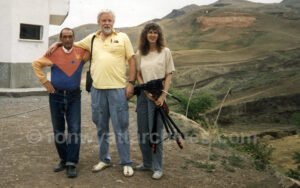
Welcome to the Ron Wyatt Archives. I'm Mary Nell (Ron's wife) and this site will attempt to fully document Ron Wyatt's work and discoveries. This website will be an ongoing project to document his work on all his various discoveries. Please check back often as new things will be added constantly.
| READ MORE |

